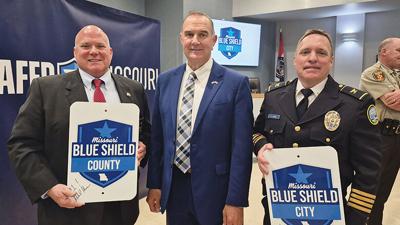This is the fourth installment in a series about the Jefferson County Sheriff’s Office and the nine major police departments in the area. This week’s installment provides information about the command staff at each of the law enforcement agencies. It also includes a story about Jefferson County Sheriff Dave Marshak, as well as another story about the retirement benefits local law enforcement officers receive.
Click here to view other stories in this series.
Compensation for the command staff at the 10 area law enforcement agencies varies widely, with Jefferson County Sheriff Dave Marshak making the highest salary, $166,154, and Cpl. Jacob Schurman of the De Soto Police Department making the lowest, $59,126.
The Sheriff’s Office spends the most on command staff salaries, $1,257,564, followed by the Arnold Police Department at $1,092,620 and then the Festus Police Department at $955,355.05. The Hillsboro Police Department has the smallest command staff cost, paying $84,151 to Chief Darrick Curtis, the only member of that department’s command staff.
Thirty-three of the 54 officers in command roles are paid less than $100,000 a year, 19 are paid less than $150,000 a year and two are paid more than $160,000 a year.
The number of command staff members at the local law enforcement agencies also varies significantly. Both the Sheriff’s Office and the Festus Police Department have 11 command officers, the highest number among the agencies. The Arnold Police Department has eight command officers.
Below is a list of the command staff officers and salaries for each of the area’s law enforcement agencies:
Arnold Police Department
- Chief Brian Carroll: $160,000
- Maj. Clinton Wooldridge: $144,092
- Lt. James Sikes: $135,408
- Lt. Joseph deRoode: $132,704
- Detective Lt. Jeremy Christopher: $130,104
- Lt. Danny Gierer: $130,104
- Lt. Thomas Leassner: $130,104
- Lt. Matthew Stiver: $130,104
- Total: $1,092,620
Byrnes Mill Police Department
- Chief Frank T. Selvaggio: $90,000
- Capt. Steve Schaffer: $66,100
- Total: $156,100
Crystal City Police Department
- Chief Chad Helms: $108,000
- Capt. Mike Pruneau: $97,000
- Lt. William Reese: $87,000
- Total: $292,000
De Soto Police Department
- Chief Jeff McCreary: $89,480
- Capt. Jeff Wynn: $80,480
- Sgt. Josh Danback: $65,900
- Sgt. Craig Newberry: $64,900
- Cpl. Michael Schneider $60,174
- Cpl. Jacob Schurman $59,126
- Total: $420,060
Eureka Police Department
- Chief Michael Werges: $140,500
- Capt./Assistant Chief Michael Tapp: $119,000
- Lt. Brett Grittini: $110,000
- Total: $369,500
Festus Police Department
- Chief Doug Wendel: $122,682.07
- Capt. Lewis Pippin: $99,743.26
- Sgt. Ben Drummond: $86,880.31
- Sgt. Alec Litzau: $86,150.23
- Cpl. Bryan Agee: $84,281.07
- Cpl. Mike Cavaness: $84,281.07
- Cpl. Racheal Bailey: $78,268.94
- Cpl. Jaclyn Duffner: $78,268.94
- Cpl. Kelsey Schleusner: $78,268.94
- Cpl. Adam Peery: $78,265.11
- Cpl. Curt Pullen: $78,265.11
- Total: $955,355.05
Herculaneum Police Department
- Chief Sharia Kyle: $90,000
- Capt. Mark Grobe: $77,000
- Detective Cpl. Jacquelyn Olsen: $65,500
- Cpl. Larry Miller: $64,000
- Cpl. Blake Collins: $64,000
- Total: $360,500
Hillsboro Police Department
- Chief Darrick Curtis: $84,151
- Total: $84,151
Jefferson County Sheriff’s Office
- Sheriff Dave Marshak: $166,154
- Chief Financial Officer and Undersheriff, Lt. Colonel Tim Whitney: $141,750
- Maj. Andy Sides: $130,000
- Capt. Brian Taylor: $108,990
- Capt. Matt Moore: $106,470
- Lt. Rob Peter: $102,349
- Lt. Gerald Williams: $102,349
- Lt. Chris Hoffman: $102,106
- Lt. Mark Nardoni: $99,132
- Lt. Mike Merchant: $99,132
- Lt. William Whitely: $99,132
- Total: $1,257,564
Pevely Police Department
- Capt. Don Moore: $80,000
- Lt. Jamie Mayberry: $70,000
- Total: $150,000

Gladys Johnson receives a certificate of recognition from Jefferson County Sheriff Dave Marshak in February 2019 at Delmar Gardens of Meramec for the kind acts she had done for Jefferson County Sheriff’s Office deputies.
Marshak reflects on his 30-plus years at the Sheriff’s Office
By Tony Krausz
When Sheriff Dave Marshak started working for the Jefferson County Sheriff’s Office more than three decades ago, he was looking for a change and an opportunity to put his skills to use in a newly created division.
Marshak, 54, who lives in the Festus area, said he was about three years into his law enforcement career and was attracted to the Jefferson County Sheriff’s Office because Oliver “Glenn” Boyer had been elected sheriff in 1992 and was revamping the agency.
“I literally heard there was a new sheriff in town,” said Marshak, who worked for the Country Club Hills and Pine Lawn police departments before joining the Sheriff’s Office in 1994.
“I was looking for a change from north St. Louis County and heard Sheriff Glenn Boyer planned to start a traffic division. With several traffic-related certifications, I wanted to apply those skills in a growing department. I didn’t move into a traffic role immediately, but from my first shift, I experienced a great connection with the community and knew Jefferson County would be home.”
Boyer said he did not hesitate to hire Marshak.
“He had a lot of talent and good things going for him,” said Boyer, who retired when Marshak took over as sheriff in January 2017 after being elected in November 2016. “He was always a good officer and had a lot of vision. Luckily, he has been able to put the vision to use since he got elected with the upgrades he has made to the Sheriff’s Office. They were all much needed upgrades.”
Becoming a cop
Marshak graduated from the Police Academy in 1991.
He said he pursued a career in law enforcement because he believes it is a noble service to protect others.
“Beyond that, law enforcement offers countless opportunities and challenges,” he said. “With the right attitude, it can be one of the most rewarding careers imaginable.”
Marshak earned a bachelor’s degree in human resource management and a master’s degree in communication with an emphasis in training and development from Lindenwood University. He also completed graduate coursework at St. Louis University and at the University of Virgina and is an FBI National Academy graduate.
He said he has instructor-level certifications from SWAT, including firearms, chemical and less lethal munitions, and has completed dozens of courses related to law enforcement, such as medicolegal death investigations, homicides, explosive breaching, hostage rescue and more.
Marshak said he has seen significant changes in law enforcement over the past 30 years, and he has tried to embrace those changes at the Sheriff’s Office.
“Our philosophy has always been to adapt and look ahead,” he said. “We’ve been vocal about where we’re heading with technology and recognize the need to balance those investments with staffing the right people to fight crime. My goal is to ensure Jefferson County remains ahead of the curve while many agencies are still catching up.”
Jefferson County career
Marshak started as a patrol officer for the Sheriff’s Office. He was promoted to training officer before moving to the special operations division, where he was assigned to SWAT.
Marshak became a team commander in the SWAT unit and then took over command of the Sheriff’s Office’s special operations division, which included overseeing SWAT; firearms; canine; traffic; DWI and alcohol enforcement; honor guard; emergency management and community relations.
Then, when he was a lieutenant he commanded nearly every division in the Sheriff’s Office, including criminal investigation.
After that, Marshak was promoted to captain and was responsible for leading the law enforcement group, which included special investigations, detectives, narcotics, special operations and road patrol.
“I’ve enjoyed every position I’ve held throughout my career,” he said. “I spent much of my career in specialized units, and each had unique rewards, from SWAT and investigations to road patrol. But there’s a particular satisfaction in obtaining a confession from a child abuser or sex offender after hours of interviewing. That moment of justice for a victim is something no other position can quite duplicate.”
In 1996, Marshak became the first Republican elected as the Jefferson County sheriff since 1930, after defeating Democrat Steve Meinberg, who at the time was a lieutenant colonel and undersheriff for the Sheriff’s Office. Since then, Marshak has been re-elected to two more four-year terms – in 2020 and 2024.
Marshak’s annual salary is $166,154.
As Marshak rose through the ranks at the Sheriff’s Office, it became clear he was capable of leading the department, Boyer said.
“It was obvious he was going places,” Boyer said. “He was always one who took direction that I gave him and ran with it. He was willing to sit, watch and listen, and then he would take what he learned and put it to good use.”
Working with others
The Sheriff’s Office is the largest law enforcement agency in the area, covering 664 square miles in unincorporated parts of the county.
The department employs 252 officers and others; and operates under an annual budget of about $36.3 million. It also assists officers who work for the eight major police departments in Jefferson County, as well as the Eureka Police Department.
“We are often in contact with the sheriff and various members of his department for law enforcement issues, such as criminal intelligence meetings, investigations and special operations,” Crystal City Police Chief Chad Helms said. “Sheriff Marshak does an outstanding job of unifying all law enforcement agencies within our county. He is continually working to improve law enforcement resources for his department, which can ultimately affect other agencies within the county.”
Arnold Police Chief Brian Carroll said Marshak is forward-thinking and points to the Jefferson County Crime Lab, which opened this summer, as an example of how the sheriff plans for the future to improve law enforcement in the county.
“That initiative wasn’t just about improving services for his own department; it was about raising the bar for the entire region,” Carroll said. “The same goes for the computer forensics unit he’s developed. He’s constantly investing in new technology to stay ahead of trends in criminal activity. We’re fortunate to have one of our detectives detached full-time to (the computer forensics) unit. That’s a significant investment on both sides.”
Eureka Police Chief Michael Werges, whose St. Louis County department borders Jefferson County, said his department works closely with the Jefferson County Sheriff’s Office. He said the Eureka Police Department has an investigator assigned to the crime lab, and he often leans on Marshak for advice.
“Sheriff Marshak leads with vision, integrity and purpose,” said Werges, who became the Eureka Police chief this year. “He is not only a leader in law enforcement, but also a mentor and someone I am truly honored to know and serve alongside.”
Byrnes Mill Chief Frank T. Selvaggio said Marshak organizes regular meetings so Jefferson County law enforcement leaders can share information with each other to improve law enforcement in the region.
“The sheriff does an excellent job with his duties in my opinion,” Selvaggio said. “There are many moving parts to his responsibilities, which he handles in a professional manner through outstanding leadership skills and delegation of duties.”
Moving forward
Boyer said Marshak has continued advancing the Sheriff’s Office.
“Not only has he done a good job with crime, but he is able to be enough of a politician – I have to admit I wasn’t that much of a politician – to get some tax increases passed to make improvements that were badly needed,” he said.
Marshak said he is proud of several accomplishments during his tenure so far, including the development of the county’s first mental health team, which has four members; the creation of the computer forensics program and construction of the crime lab. He also is proud of getting updated vehicles and equipment for deputies, especially those assigned to SWAT.
He said plenty of improvements still need to be made at the Sheriff’s Office.
“Investing in people remains critical,” he said. “We must also enhance our real-time intelligence capabilities. The volume of available data today demands a central intelligence hub where information is analyzed and shared quickly to support officers and investigators. Additionally, we need to address our facility needs, including a modern firearms range and upgrades to our aging jail.”
Area officers earn pension benefits
By Teresa Inserra
All the law enforcement officers at the Jefferson County Sheriff’s Office and the nine other major police departments in the area participate in the Local Government Employees Retirement System (Missouri LAGERS) or a similar defined benefit retirement plan.
To be eligible to receive LAGERS retirement benefits, an officer must first become vested by earning five years of credited service within the LAGERS system either at one employer or a combination of LAGERS employers.
Arnold Police officers are the only ones in Jefferson County that don’t participate in LAGERS.
How LAGERS works
As part of a compensation package, the employer contributes to the LAGERS retirement fund for each officer.
Under LAGERS, benefit program multipliers, ranging from 1 to 2.5 percent, are applied to the officer’s final average salary and then by the years of credited service to determine the officer’s pension, or monthly income for life.
The city of Festus, like Eureka, Crystal City and Herculaneum, provide a 2 percent multiplier for their officers’ pensions. The county provides a 1.75 percent multiplier for the Sheriff’s Office, as does the city of De Soto for its police department. Pevely and Hillsboro provide a 1.5 percent multiplier, and Byrnes Mill offers the lowest multiplier, at 1 percent.
Most do not require an employee contribution, although Herculaneum and Byrnes Mill employees must pay into LAGERS, with Herculaneum officers contributing 4 percent and Byrnes Mill officers contributing 2 percent.
New to LAGERS
Byrnes Mill only recently joined LAGERS after voters in April agreed to allow the city to charge its 2.5 percent sales tax on internet purchases, which is estimated to bring in more than $20,000 in annual revenue, and the city is using that revenue for the LAGERS program.
Mayor Rob Kiczenski said LAGERS will provide much better retirement benefits for the city’s employees than the previous retirement program, which is no longer offered. He said the better pension program will help the city attract and retain employees.
He said the city didn’t want to overcommit its first year above a 1 percent multiplier because once an agency is in LAGERS, it is committed to LAGERS indefinitely. He said the city could change its multiplier and employee’s required contributions after two years.
Byrnes Mill and Eureka offer their officers the Rule of 80, an early retirement option.
“What that means is when the officer’s years of service plus their age equals 80, they are eligible to retire,” Eureka Police Chief Michael Werges said.
Without the Rule of 80, the LAGERS retirement age for police officers is 55.
“As first responders, it is recognized we face a unique set of challenges and demands from our job; therefore, we are eligible for retirement benefits at age 55,” Crystal City Police Chief Chad Helms said of LAGERS. “This is one of several very important factors that helps to attract and retain personnel in a very competitive job market.”
Alternative plans
While Arnold Police officers do not participate in LAGERS, the city offers a similar retirement program for them.
“(Our police officers) participate in a private pension fund where they contribute 8.5 percent of their pay,” Arnold Police Chief Brian Carroll said, adding that other Arnold city employees are enrolled in LAGERS. “The city also contributes to this fund, and the percentage fluctuates depending on the overall health of the pension fund.”
Carroll said the private pension fund has been in place since the 1970s and is competitive with LAGERS. Officers can also contribute to a 457 retirement savings plan, but the city does not contribute to that.
“We also offer retiree health insurance,” Carroll said. “Officers who retire at the age of 55 with at least 20 years of service with the Arnold Police Department are eligible for health coverage until they reach the age of 65.”
De Soto, Eureka, Hillsboro and Pevely offer employees an opportunity to participate in a supplemental 457(b) retirement plan, a plan offered by state, local governments and some nonprofits. However, the cities do not offer a match for the employees’ contributions.
Festus is the only area city to provide a 457(b) retirement plan with a city match.
“(The city of Festus offers) a 457 retirement plan through Nationwide,” said Festus Police Chief Doug Wendel. “This is an employee contribution fund with a city match. If the employee contributes 3 percent to 5 percent of their salary, the city will match with 1 percent. If the employee contributes 6 percent or more of their salary, the city will match 3 percent.”
Recruitment, retention tool
Festus City Administrator Greg Camp said providing a robust benefits package, including a defined retirement benefit through LAGERS, is important as the city competes for employees in the public and private sectors.
“(Festus) Mayor (Sam) Richards and the City Council are extremely proud of the city’s best asset – our employees,” Camp said.
Wendel said offering good retirement benefits helps recruit and retain employees, at least to a certain extent.
“I think it helps attract more experienced officers who are starting to think about retirement, but I’m not sure how much younger officers think about retirement when they are starting their career,” he said.
Pevely Capt. Don Moore, that city’s interim police chief, agreed.
“(Offering retirement benefits) helps employees who have a long-term goal in mind,” he said. “For many young employees in various industries, retirement benefits are not always a top priority. However, for retention, having a solid retirement program and benefits is essential.”
Hillsboro Police Chief Darrick Curtis said today’s applicants are more interested in retirement benefits.
“It seems like years ago no one asked about these things,” he said. “Candidates just wanted to go to a good department. Now, almost all of our candidates – even the younger ones – want to know about benefits. It’s definitely something they’re looking at.”
In addition to having LAGERS, Jefferson County deputies also must participate in the Missouri County Employee’s Retirement Fund and contribute 4 percent of their pay toward that.
“Retirement benefits do, in part, contribute to attracting and retaining quality employees,” Jefferson County Sheriff’s Office Undersheriff Tim Whitney said. “When people know their long-term future is valued and supported, they’re more likely to commit to the organization until retirement. That stability not only reduces turnover but also strengthens the overall health and consistency of the department.”







